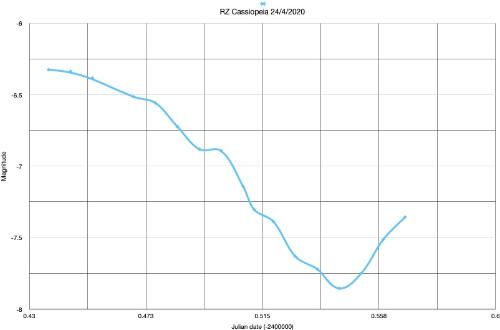Differential Photometry with a DSLR
Posted by stevepd100@gmail.com on May 05, 2020; 10:25pm
URL: http://astroimagej.170.s1.nabble.com/Differential-Photometry-with-a-DSLR-tp1341.html
I've just noticed that my first question has been answered elsewhere! The textbox issue, and I've been doing the correct thing it seems. :-)
I'm pretty new to this so I hope my next question doesn't across as too simplistic! I'm an amateur and I've become interested in taking a series of photos of a variable, such as RZ Cass as a starter, and then use AIJ to produce a light curve, so it's my methodology that I'm a little unsure of. I'd be interested to know whether I'm dropping any clangers or doing some absolute No, Nos!
I took about 85 shots of RZ Cass recently, in batches of 5, each 5 secs long, and the batches were 10 mins apart. I am using a Canon 60D, with a 100mm lens, and I used my telescope mount to track the star. I then use Fitswork to convert the RAW CR2 files into RGB FITS files. I discard the R and B and just use the green. My first problem is that if I stack each batch I lose the time in the FITS header. So I have used AIJ to plot the mag of RZ Cass in all of 85 images, and I have then set up a spreadsheet to measure the average of the 5 images in each batch, and I have used the time from the middle image to plot the graph. Am I correct in stacking the Green FITS images rather than the RAW files? (I forgot to say that I also take calibration shots).Is there a way, either with AIJ or another mean, of stacking images and having the middle time put into the resulting image?
For a first attempt I was quite pleased wit the resulting curve, but before I start to think about sending data to the BAA variable star section I want to improve my accuracy so the final question basically is, am I deluding myself that this method will provide worthwhile results?
Steve

URL: http://astroimagej.170.s1.nabble.com/Differential-Photometry-with-a-DSLR-tp1341.html
I've just noticed that my first question has been answered elsewhere! The textbox issue, and I've been doing the correct thing it seems. :-)
I'm pretty new to this so I hope my next question doesn't across as too simplistic! I'm an amateur and I've become interested in taking a series of photos of a variable, such as RZ Cass as a starter, and then use AIJ to produce a light curve, so it's my methodology that I'm a little unsure of. I'd be interested to know whether I'm dropping any clangers or doing some absolute No, Nos!
I took about 85 shots of RZ Cass recently, in batches of 5, each 5 secs long, and the batches were 10 mins apart. I am using a Canon 60D, with a 100mm lens, and I used my telescope mount to track the star. I then use Fitswork to convert the RAW CR2 files into RGB FITS files. I discard the R and B and just use the green. My first problem is that if I stack each batch I lose the time in the FITS header. So I have used AIJ to plot the mag of RZ Cass in all of 85 images, and I have then set up a spreadsheet to measure the average of the 5 images in each batch, and I have used the time from the middle image to plot the graph. Am I correct in stacking the Green FITS images rather than the RAW files? (I forgot to say that I also take calibration shots).Is there a way, either with AIJ or another mean, of stacking images and having the middle time put into the resulting image?
For a first attempt I was quite pleased wit the resulting curve, but before I start to think about sending data to the BAA variable star section I want to improve my accuracy so the final question basically is, am I deluding myself that this method will provide worthwhile results?
Steve

| Free forum by Nabble | Edit this page |